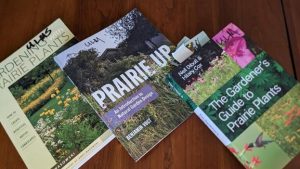By Emmy Ulmschneider
and Debbie Roland
Master Gardeners
You want to learn about more about establishing an urban prairie, but where do you start? The good news is that there are so many books and digital resources to help. This idea of using native plants is not new. Sally and Andy Waskowski published their first book Native Texas Plants, Landscaping Region by Region back in 1988! So, here are a few choices to help you get started.
If you are interested in the importance and urgency of creating native habitat in our urban areas, one of the best places to start is with Doug Tallamy. His book Nature’s Best Hope provides a blueprint for individual conservation in your yard creating a new type of national park. Explore the videos, talks, and resources on the Homegrown National Park website and check out the number of people who are already “on the map” by creating habitat in their own yards. And by the way, Midland is on the map with three users.

If you have already decided that you would like to try and create a prairie in your own yard, but need more background, Sally and Andy Waskowski published Gardening with Prairie Plants in 2002. This classic covers how to install and maintain an urban prairie as well as 143 pages of plant profiles for grasses, forbs, shrubs, and trees for regional prairie types.
Believe it or not, there is a Native Prairies Association of Texas (NPAT) which conserves, restores, and educates about our native prairies and grasslands. Although most of their information centers around tallgrass prairies, they do have a good primer on prairie gardening: texasprairie.org/prairie-gardening
Closer to home, the Lady Bird Johnson Wildflower Center has a variety of resources including how-to instructions and plant information. In addition to written resources, their plant database is a wealth of information. You can check out an individual plant and through their link to the USDA Plant Database see if a certain plant grows in your county. The option for Special Collections allows you to see plant profiles for selected areas. So, if you want to use that try the Rolling Plains or Chihuahuan Desert ecoregion.
You have researched native plants you want to grow; you have the perfect pocket prairie area, and you have an idea about how to install it. But now you need a map or design to follow. As we wrote about in our article on Planning for Year-Round Color (Blog Entry 3/20/2023) recreating nature takes planning. Although inspirational, Piet Odolf is not the only one to write about creating a landscape that has all the benefits of a natural space but has been carefully thought out and designed. If you are interested in what is possible with prairie plants and want a step-by-step guide through the whole process including design, you can’t do better than Prairie Up by Benjamin Vogt. Vogt focuses on all things prairie from how to start to how to enjoy your prairie.
If you have questions, call the AgriLife office in Odessa at 498-4071 or in Midland at 686-4700.
Additional information, and our blog for access to past articles, is available at westtexasgardening.org. Click on “Resources.”




